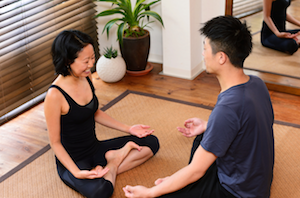Can Meditating Together Improve Your Relationships?
By Jill Suttie
New research suggests that there are some unique social benefits to partner meditation.

New research suggests that there are some unique social benefits to partner meditation.
After being a meditation skeptic for years, I finally took a meditation course with my husband. It definitely helped me calm my nerves and focus a bit better, and it even seemed to improve my interactions with others, including him.
But after the class was over, I started meditating every morning on my own and felt a bit, well, lonely. I missed the closeness and relational benefits I’d experienced when meditating in tandem with my husband.

As it turns out, those benefits are real: New research out of the Max Plank Institute in Germany suggests that practicing “dyadic meditation”—where two people meditate together—may help us feel closer and more open with others.
Lead researcher Bethany Kok first became interested in dyadic meditation when she heard people talking about the potential pro-social benefits of meditating alone.
“It seemed to me that if solitary meditation can teach those skills, then dyadic meditation could do so even more effectively,” she said.
To test this theory, participants went through a nine-month meditation training with three modules designed to increase presence (awareness of the present moment) via breathing and body scan meditations; pro-social affect (or emotion) via loving-kindness meditation, compassion training, and learning to accept difficult emotions; and perspective via observing thoughts and distancing oneself from those thoughts. These modules are part of the Institute’s ReSource Project—a longitudinal study looking at the impacts of different meditation practices on mental health and social skills.
For this study, participants were randomly paired each week to try out novel partner meditation exercises. During the “affect” module, partners took turns sharing their feelings and body sensations while recalling difficult experiences in their lives versus gratitude-eliciting ones. During the perspective module, partners took turns talking about a recent experience of theirs from different perspectives—for example, as if they were a judge in a courtroom or a loving parent—while the other partner listened carefully and tried to infer the perspective being taken.
Before and after these modules, participants reported on how much social closeness they felt toward partners and how much they felt willing to share information about themselves with partners (self-disclosure). Participants also ranked how motivated and committed they were to practicing each of the different meditations, as well as how much they liked each one.
Results showed that participating in the partner exercises increased feelings of closeness and increased their willingness to self-disclose with partners over time—even though the partners changed each week. This suggests that dyadic meditation helps strengthen social relationships, in general, and not just to a specific partner.
“By increasing feelings of closeness, and by encouraging people to reach out to others through self-disclosure, we are laying a groundwork to prevent loneliness in the future,” says Kok. If that’s true, she adds, partner meditation could help people stave off the mental and physical problems that are associated with social isolation, like poor cognitive function, heart disease, and premature mortality.
How does meditating together create feelings of closeness? Kok believes that too often during regular social conversations, people spend time thinking of what to say, imagining what they’d rather be doing, or judging the other person—in other words, not being present. Dyadic meditation offers something potentially different: accepting people as they are and paying close attention.
In general, participants were no less motivated or committed to doing the partner meditations than to traditional, solitary meditations that were included in the program. Interestingly, participants actually rated the dyadic portions of the modules higher than solitary practices, suggesting they are welcome and feasible add-ons to meditation training. The affect dyad was rated the highest of all practices.
These findings suggest that adding a dyadic experience to meditation could benefit those who have problems connecting to others or suffer from chronic loneliness. And they point toward the possibility of tailoring meditation practices to specific needs.
“I like to use a sports metaphor. Many sports are good for the body, but each individual sport has specific and unique physical effects,” Kok says. “In the same way, many contemplative practices are beneficial, but what we are seeing here is that the benefits vary depending on what practice you do. This is an important frontier in contemplative research.”